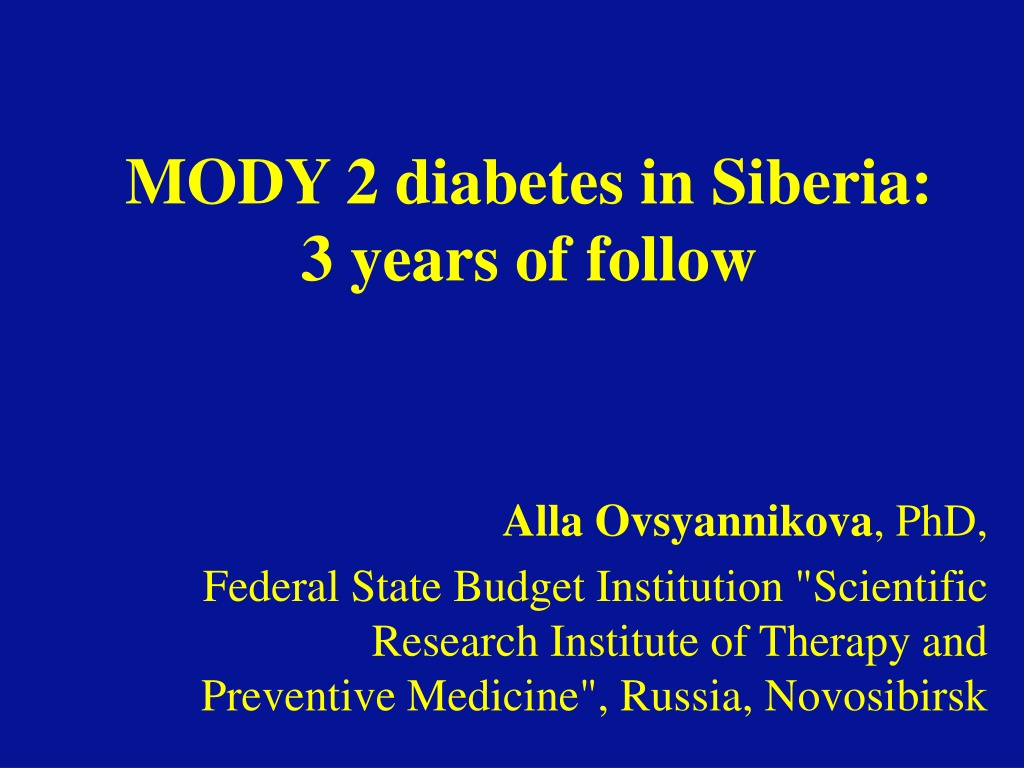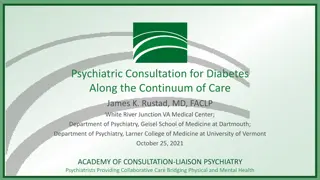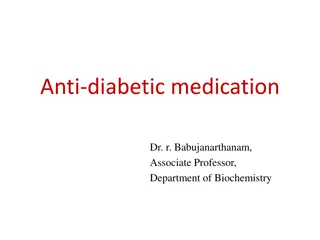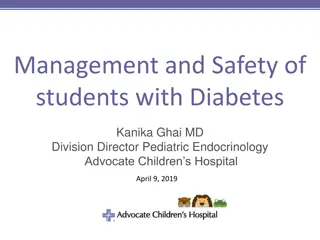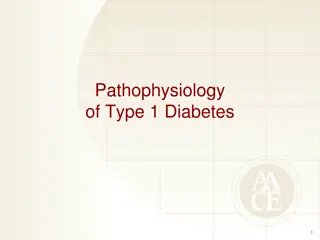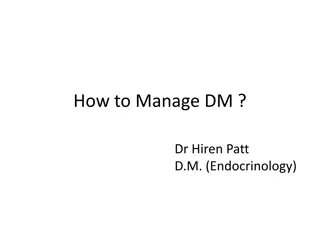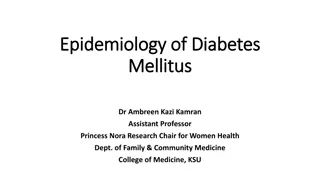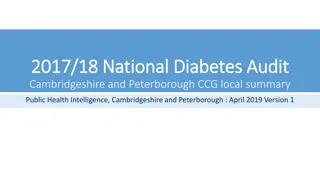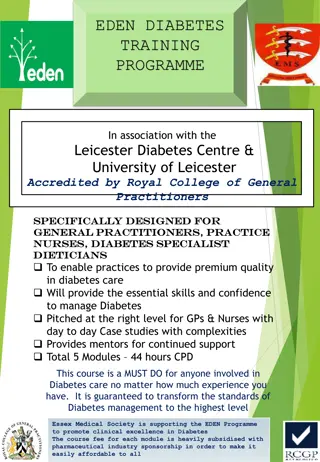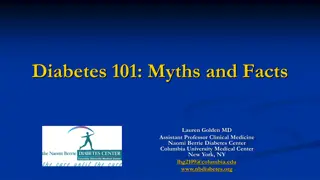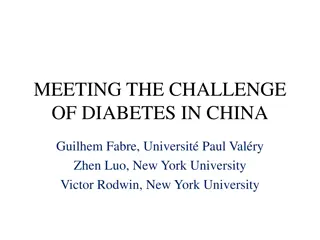Understanding MODY Diabetes: Characteristics and Prevalence in Russia
Maturity-Onset Diabetes of the Young (MODY) is a monogenic form of diabetes that often manifests before the age of 25, with distinct clinical features and modes of inheritance. In Siberia, Russia, MODY prevalence and its various subtypes have been a subject of research, shedding light on its unique characteristics. The population in Novosibirsk, Russia contributes significantly to the overall diabetes cases in the country. The study emphasizes the importance of recognizing MODY, its distinguishing features such as absence of ketoacidosis, and the significance of genetic factors in its diagnosis and management, offering a comprehensive overview of this specific diabetes subtype.
Download Presentation

Please find below an Image/Link to download the presentation.
The content on the website is provided AS IS for your information and personal use only. It may not be sold, licensed, or shared on other websites without obtaining consent from the author. Download presentation by click this link. If you encounter any issues during the download, it is possible that the publisher has removed the file from their server.
E N D
Presentation Transcript
MODY 2 diabetes in Siberia: 3 years of follow Alla Ovsyannikova, PhD, Federal State Budget Institution "Scientific Research Institute of Therapy and Preventive Medicine", Russia, Novosibirsk
Russia The population in Russia is 146 519 759 people, in Novosibirsk 1,584,000
The number of patients with DM in Russia Russia Novosibirsk millions 3.5 3 2.5 2 1.5 1 0.5 0 DM type 1 type 2
Prevalence of DM in youth in Russia* 3 % 12 % type DM 1 nonimmune forms of DM LADA 85 % * Kuraeva, T., Zilberman L., Titovich E., Peterkov V. Genetics of monogenic forms of diabetes .Diabetes. - 2011. - 1. - P. 20-27.
The prevalence of nonimmune forms of DM in Russia* n=296 MODY DIDMOND 13 % neonatal DM 36 % 17 % rare forms DM 2 % syndrome of Alstrem type 2 DM 4 % 12 % 16 % *Peterkov V. et al. Molecular genetics and clinical features monogenic forms of diabetes. Herald RAMN.- 2012. - 1.- pp 81 - 86.
Clinical characteristics of MODY and type 2 diabetes CHARACTERISTIC MODY TYPE 2 DIABETES Mode of inheritance Monogenic, autosomal dominant Childhood, adolescence or young adulthood (<25yr) Usually multigenerational 80-95% Nonobese Absent Polygenic + environment Adulthood (40-60yr) occasionally adolescence (obese) Rarely multigenerational Variable (~10-40%) Usually obese Usually present Age of onset Pedigree Penetrance Body habitus Metabolic syndrome M. Vaxillaire et al., 2006
Definition of MODY S. Fajans R.Tattersall entered abbreviation of MODY in 1965 year first mutation (gene glucokinase) was diagnosed in 1992 five subtypes of MODY were identified in 2002 NOW: 13 subtypes of MODY
Characteristics of MODY diabetes* relatives with disorders of carbohydrate metabolism; manifestation of DM before the age of 25 years; the absence of ketoacidosis; good compensation (HbA1c 7%) diabetes; long-term (at least 1 year) remission ("honeymoon diabetes") without periods of decompensation; preservation of the secretory activity of beta cells (the level of C- peptide is in the normal range or slightly reduced); Absence of markers of autoimmune response against beta cells (antibodies to beta-cells, GAD, insulin); Absense of obesity; absence of association with HLA. *M. Vaxillaire et al., 2006, Ch. Henzen, et al., 2012 ;
Pancreatic -Cell and the Proteins Implicated in MODY Glucose sensing Insulin gene expression N Engl J Med, Vol. 345, No. 13, September 27, 2001
MODY types* HNF 4a (hepatocyte nuclear factor) GCK, HNF-1a, IPF (insulin promoter factor), HNF-1b, NEUROD1 KLF-11, CEL, PAX-4, INS, BLK ABCC8 New types (2012) KCNJ11 Ch.. Henzen, 2012, B. Johansson,.2011, Bowman et al ., 2012
Prevalence of subtypes MODY diabetes MODY 2-5% of all cases of diabetes, in the UK up to 10%. MODY 3: MODY 2: ,
Prevalence of subtypes MODY diabetes in Russia MODY 2 = MODY 3
Phenotype of MODY 2* Symptoms; Can begin to Good compensation; Moderate fasting hyperglycemia (not more than 6.5 mmol / l); OGTT: increase in blood glucose of less than 3.5 mmol / l; Neuropsychiatric disorders 7.5%; Absence obesity. *A. Senatorova et al., 2009
Characteristics of carbohydrate metabolism in MODY 2 n=67 14 % normal glucose 48 % DM 38 % hyperglicemia 2 Russian Congress Innovative technologies in endocrinology (may 2014)
Treatment of MODY 2 Children Adult 7 %7 % diet insulin drugs 86 % 27 % diet insulin drugs 3 % 70 % 2 Russian Congress Innovative technologies in endocrinology (may 2014)
MODY GCK in Siberia* The purpose: to identify the clinical features of MODY GCK diabetes which we need to follow of this group of patients. *The reported study was supported by RSCF, research project No. 14-15-00496.
Materials and methods: - diagnose of MODY GCK during the molecular genetic testing of glucokinase gene; - once a year: full clinical examination, blood samples for biochemical determination of C-peptide antibodies to b- cells, microalbuminuria, abdominal ultrasound, heart and thyroid ultrasound, examination of ophthalmologist. research, and TSH,
Results Patients with MODY GCK: 14 peoples (8 probands +6 relatives)= 6 males (43%) and 8 (57%) female. The average age of the probands was 12 2,6 years. Age of onset ranged from 3 months to 32 years. Median of duration of diabetes was 3 years. Hereditary: 93% of patients had relatives with disorders of carbohydrate metabolism, 1 patient had mutation denovo .
Results Mutations were in 1 ekzon, 3, 4, 5, 7 of GCK gene. Mutation 60 C > T
Results DEBUT: 14 12 10 8 6 Patients with MODY 2 4 2 0 asymptomatic debut fasting hyperglycemia
Results DEBUT: % 100 80 60 40 20 0 thyroid pathology allergic reactions dyslipidemia bronchial asthma arterial hypertension
Results Diabetescomplications: 1 patient (7%) had diabetic nephropathy, chronic kidney disease, Stage 1, category 2 (A2).
Results 3 YEARS OF FOLLOW UP: Overweight and obesity were not detected in any patient. The same patient had no progressive diabetic nephropathy. Biochemical analysis: no changes.
Results HbA1c % 6 6.2 6.4 6.6 C- peptide ng/ml 0.7 0.9 1.1 3 years of follow Debut
Results % 100 80 60 40 20 0 Diet Insulin 3 years of follow Oral drugs Debut
Conclusions 1. The earliest age of clinical manifestations of disorders of carbohydrate metabolism in MODY 2 diabetes was six months which should be considered in the differential diagnosis with type 1 diabetes because it is also manifest in a younger age group. 2. MODY 2 diabetes had oligosymptomatic onset, soft flow, good compensation of carbohydrate metabolism, no complications, exogenous insulin in most cases. no need for
Clinical case Patient D. (boy) 2002 year of birth. 2010 year: thirst, itchy skin. Fasting hyperglycemia 6,5 mmol/l (capillary hyperglycemia 8,9 mmol/l, HbA1c 5,9 %. Antibodies to b cells, GAD negative. The patient had diabetic nephropathy, chronic kidney disease, Stage 1, category 2 (A2). blood), postprandial
Clinical case Relatives of the patient did not have diagnosis of diabetes. 2012 genetic research of GCK gene. Mutation 146 (146C > G) was detected. Probands parents were examined. Father had asymptomaticfasting hyperglycemia. He was examined and same mutation was detected.
Pedigree Hyperglycemia Hyperglycemia MODY 2 MODY 2
Clinical case Probands father had mild hypertension. 7 6 5 4 3 2 1 0 HbA1c 2012 HbA1c 2015 Father Proband
Clinical case Treatment in 2012: - Patient: Insulin (4-6 U Detemir) - Father: diet. Treatment in 2015: - Patient: glibenclamid tab 1,75mg - Father: diet.
Alla Ovsyannikova aknikolaeva@bk.ru Thank you for your attention!
